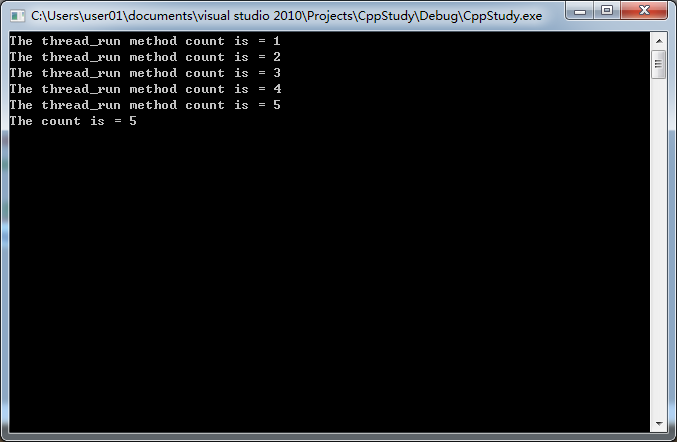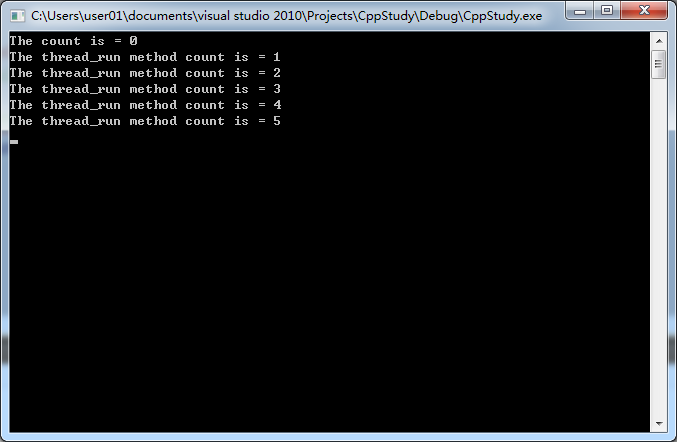дёҖгҖҒдҪҝз”Ёж–№ејҸ
pthread_t tid;
pthread_create(&tid, NULL, thread_run,NULL);
pthread_join(tid,NULL);
еҲӣе»әзәҝзЁӢд№ӢеҗҺзӣҙжҺҘи°ғз”Ёpthread_joinж–№жі•е°ұиЎҢдәҶгҖӮ
дәҢгҖҒдёәд»Җд№ҲиҰҒдҪҝз”Ёpthread_join()
В В В еңЁеҫҲеӨҡжғ…еҶөдёӢпјҢдё»зәҝзЁӢз”ҹжҲҗ并иө·еҠЁдәҶеӯҗзәҝзЁӢпјҢеҰӮжһңеӯҗзәҝзЁӢйҮҢиҰҒиҝӣиЎҢеӨ§йҮҸзҡ„иҖ—ж—¶зҡ„иҝҗз®—пјҢдё»зәҝзЁӢеҫҖеҫҖе°ҶдәҺеӯҗзәҝзЁӢд№ӢеүҚз»“жқҹпјҢдҪҶжҳҜеҰӮжһңдё»зәҝзЁӢеӨ„зҗҶе®Ңе…¶д»–зҡ„дәӢеҠЎеҗҺпјҢйңҖиҰҒз”ЁеҲ°еӯҗзәҝзЁӢзҡ„еӨ„зҗҶз»“жһңпјҢд№ҹе°ұжҳҜдё»зәҝзЁӢйңҖиҰҒзӯүеҫ…еӯҗзәҝзЁӢжү§иЎҢе®ҢжҲҗд№ӢеҗҺеҶҚз»“жқҹпјҢиҝҷдёӘж—¶еҖҷе°ұиҰҒз”ЁеҲ°pthread_join()ж–№жі•дәҶгҖӮ
В В В еҚіpthread_join()зҡ„дҪңз”ЁеҸҜд»Ҙиҝҷж ·зҗҶи§Јпјҡдё»зәҝзЁӢзӯүеҫ…еӯҗзәҝзЁӢзҡ„з»ҲжӯўгҖӮд№ҹе°ұжҳҜеңЁеӯҗзәҝзЁӢи°ғз”ЁдәҶpthread_join()ж–№жі•еҗҺйқўзҡ„д»Јз ҒпјҢеҸӘжңүзӯүеҲ°еӯҗзәҝзЁӢз»“жқҹдәҶжүҚиғҪжү§иЎҢгҖӮ
дёүгҖҒд»Јз Ғе®һйӘҢ
еҸҜд»ҘйҖҡиҝҮд»Јз ҒжқҘзңӢзңӢжү§иЎҢзҡ„ж•ҲжһңпјҢе°ұзҹҘйҒ“дәҶпјҡ
#include "stdafx.h"
#include <pthread.h>
#include <stdio.h>
#include <Windows.h>
#pragma comment(lib, "pthreadVC2.lib")
static int count = 0;
void* thread_run(void* parm)
{
for (int i=0;i<5;i++)
{
count++;
printf("The thread_run method count is = %d
",count);
Sleep(1000);
}
return NULL;
}
int main()
{
pthread_t tid;
pthread_create(&tid, NULL, thread_run,NULL);
// еҠ е…Ҙpthread_joinеҗҺпјҢдё»зәҝзЁӢ"main"дјҡдёҖзӣҙзӯүеҫ…зӣҙеҲ°tidиҝҷдёӘзәҝзЁӢжү§иЎҢе®ҢжҜ•иҮӘе·ұжүҚз»“жқҹ
// дёҖиҲ¬йЎ№зӣ®дёӯйңҖиҰҒеӯҗзәҝзЁӢи®Ўз®—еҗҺзҡ„еҖје°ұйңҖиҰҒеҠ joinж–№жі•
pthread_join(tid,NULL);
// еҰӮжһңжІЎжңүjoinж–№жі•еҸҜд»ҘзңӢзңӢжү“еҚ°зҡ„йЎәеәҸ
printf("The count is = %d
",count);
getchar();
return 0;
}
еҠ дәҶpthread_join()ж–№жі•зҡ„жү“еҚ°пјҡ

еҰӮжһңжҠҠйҮҢйқўзҡ„pthread_join()ж–№жі•жіЁйҮҠжҺүзҡ„жү“еҚ°пјҡ

еҸҜд»ҘзңӢеҫ—еҮәжқҘпјҢеҰӮжһңжІЎжңүеҠ pthread_join()ж–№жі•пјҢmainзәҝзЁӢйҮҢйқўзӣҙжҺҘе°ұжү§иЎҢиө·иө°дәҶпјҢеҠ дәҶд№ӢеҗҺжҳҜзӯүеҫ…зәҝзЁӢжү§иЎҢдәҶд№ӢеҗҺжүҚжү§иЎҢзҡ„еҗҺйқўзҡ„д»Јз ҒгҖӮ

